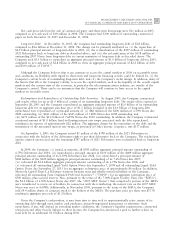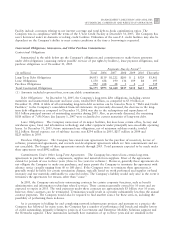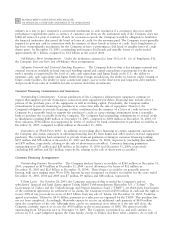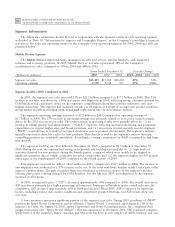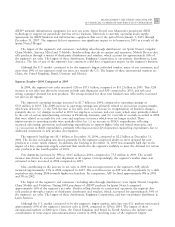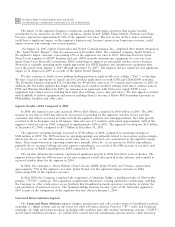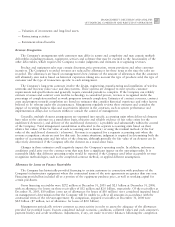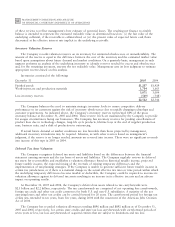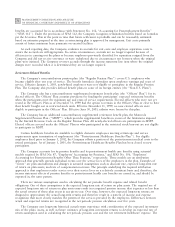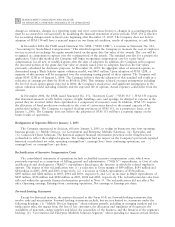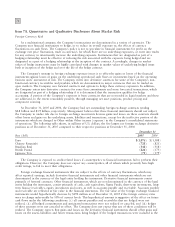Motorola 2005 Annual Report Download - page 72
Download and view the complete annual report
Please find page 72 of the 2005 Motorola annual report below. You can navigate through the pages in the report by either clicking on the pages listed below, or by using the keyword search tool below to find specific information within the annual report.
65
MANAGEMENT'S DISCUSSION AND ANALYSIS
OF FINANCIAL CONDITION AND RESULTS OF OPERATIONS
operators, (iv) digital satellite program distribution systems, (v) direct-to-home (""DTH'') satellite networks and
private networks for business communications, and (vi) advanced video communications products. In 2005, the
segment's net sales represented 8% of the Company's consolidated net sales, compared to 7% in 2004 and 8% in
2003.
Years Ended December 31 Percent Change
(Dollars in millions)
2005
2004 2003
2005Ì2004
2004Ì2003
Segment net sales $2,765 $2,214 $1,745 25% 27%
Operating earnings (loss) 185 146 48 27% 204%
Segment ResultsÌ2005 Compared to 2004
In 2005, the segment's net sales increased 25% to $2.8 billion, compared to $2.2 billion in 2004. The increase
in overall net sales was driven by increases in both ASP and unit shipments of digital set-top boxes. Net sales
increased in North America, Latin America and Asia, partially offset by a slight decrease in net sales in EMEA. Net
sales in North America continue to comprise a significant portion of the segment's business, accounting for 84% of
the segment's total net sales in 2005, compared to 83% in 2004. The segment's backlog was $424 million at
December 31, 2005, compared to $305 million at December 31, 2004.
The segment generated operating earnings of $185 million in 2005, compared to $146 million in 2004. The
improvement in operating results was primarily due to the 25% increase in net sales, partially offset by increased
product costs due to increased sales of higher-end products, mainly HD/DVR set-top boxes. Although HD/DVR
set-top boxes carry a higher ASP, the higher costs on the HD/DVR set-top box line caused gross margin as a
percentage of sales to decrease in 2005, compared to 2004. R&D and SG&A expenditures increased in total, but
decreased as a percentage of net sales, primarily due to the increase in net sales.
In 2005, net sales of digital set-top boxes increased 34%, due to increases in both ASP and unit shipments. The
increase in ASP was driven by a product-mix shift towards higher-end products, particularly HD/DVR set-top
boxes. The increase in unit shipments was primarily due to the increased spending by cable operators. The segment
continued to be the worldwide leader in market share for digital cable set-top boxes.
In 2005, net sales of cable modems increased 9%. The increase in net sales was due to an increase in cable
modem unit shipments, which was partially offset by the decline in ASP for cable modems. The decrease in ASP
was primarily due to increased competition. The segment retained its leading worldwide market share in cable
modems.
Demand for the segment's products depends primarily on the level of capital spending by broadband operators
for constructing, rebuilding or upgrading their communications systems and services. After a number of years of
decreased capital spending, in 2004 and 2005 our cable operator customers increased their purchases of the
segment's products and services, primarily due to increased demand for advanced digital set-top boxes to provide
HD/DVR functionality.
The segment is dependent upon a small number of customers for a significant portion of its sales. Because of
continuing consolidation within the cable industry, a small number of large cable television multiple system
operators (""MSOs'') own a large portion of the cable systems and account for a significant portion of the total
capital spending. In 2005, net sales to the segment's top five customers represented 53% of the segment's total net
sales. Net sales to the segment's largest customer, Comcast, accounted for 31% of the total net sales of the
segment. The loss of business from any major MSO could have a significant impact on the segment's business.
During the first quarter of 2005, Motorola and Comcast entered into a broader strategic relationship that
includes an agreement for a multi-year set-top box commitment. This agreement extended Comcast and Motorola's
agreement for Comcast to purchase set-top boxes and network equipment, including HD/DVR and standard-
definition entry-level set-top box models. As part of this strategic relationship, Motorola and Comcast also formed
two joint ventures that will focus on developing and licensing the next generation of conditional access
technologies.
On February 24, 2006, the segment completed the acquisition of Kreatel Communications AB (""Kreatel''), a
leading developer of innovative IP based digital set-top boxes. IPTV, or the video component of the triple play, is
expected to be the primary focus for telecommunication companies around the world as it offers a significant
competitive tool versus cable operators. The segment plans to integrate Kreatel's set-top boxes into its current suite


